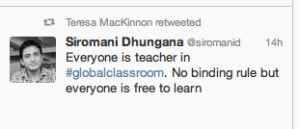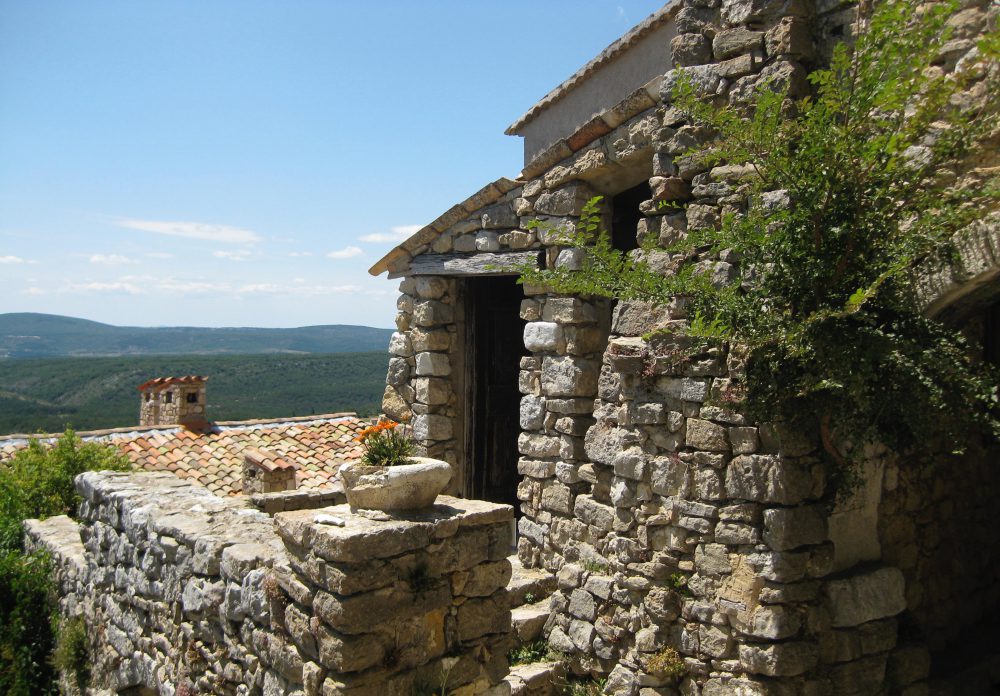Why Connect?
Over the past couple of weeks, I’ve participated in multiple activities of Connected Educators Month. It’s evident. Walls tumble down that separate educators from each other as they connect around the world. New ideas proliferate as a participation culture emerges. In my own district, connected educators create new pathways for learning – for themselves, colleagues locally and around the world, and their children. The key word among connected educators during #CE13 seems to be share – whether in a Pinterest “PD Scavenger Hunt” or through a school-wide tweetup on what choice and comfort looks like for children.
We benefit from professional connectivity because it helps us make eye contact with other educators across global watering holes. That’s a step in removing filters that prevent us from learning with and from each other. Yesterday I caught a bit of chat at #globalclassroom and had a chance to witness how we filter across diverse cultures, experiences, and time zones. In virtual environments, exchanges at watering holes open us to new ways of thinking – multiple points of view from around the globe – and as we interact we find our perspective isn’t the only one out there.
Such connectivity helps us take down our professional filters and see what’s outside our walls, our boundaries, and our barriers. When we connect, our natural human curiosity and urge to explore causes us to seek what’s beyond our known learning horizons. When we discover others with different ideas at virtual watering holes, that leads to questions about our own filters. I believe that’s a good thing.
 Reflecting on Filters
Reflecting on Filters
A mentor once said to me that we all have to watch out for our filters. He was a mentor before the topic of “the filters”, you know the ones I mean, became a different kind of headache for contemporary educators. But, I think his reference applies to any kind of filters in our lives, even virtual ones.

- Using desk surfaces as a writing space challenged my filtering system – until I saw the walls and windows at NPR covered with notes, diagrams, and outlines.
Over-filtering represents one of the greatest sources of failures in our individual thinking and that of our systems. It’s why I keep a mental list of the four failures of government – imagination, policy, management, and capability – that the 9/11 Commission identified in their final report as root causes of 9/11. It’s why I am conscious of Ellen Langer’s mindful leadership as a frame for thinking about why individual leaders working alone are poor predictors of the future. It’s why I believe in finding new pathways to advance our work and the concept of “terroir” and scaling across not up (from Walk Out, Walk On), rather than thinking all schools should or can implement identical solutions, even when they’re trying to address the same challenges. Why?
There are no “one size fits all” answers. There are no magic formulas. In this day and age, there are no standard problems, and no standard solutions. Pentagon staffers articulate that in their work, and so should we. No two school communities, no two grade-level teams, and no two parents, children or teachers are exactly alike. As @yongzhaoUO says, we need to consider the uniqueness of the local work we do rather than focusing on mass standardization.
Filters tend to push us towards seeing different situations similarly, rather than recognizing that no two are the same. Filters tend to cause us to go to the same people for feedback – often people who reinforce our own perspectives and ideas. Filters are why we lack the capability over time to see watermarks on our own professional wallpaper. Filters are why in our work as educators we don’t always get or attend to the full breadth and depth of information we need. Filters can be our worst enemy when it comes to decision-making.
We all filter.
Our brains must filter to accomplish anything in a given day. Other people also filter for us. Sometimes because they see it as necessary to getting work done in priority order. Sometimes, it’s to advance someone’s perspective. We need to be aware of that and constantly monitor how our filters, and those of others, impact our work, and ultimately impact how our work impacts young people we serve.
When we work in isolation, and we all do need that time sometimes, we don’t consider a full range of ideas and possibilities to help find solutions to challenges in front of us. While I’m not an impulsive person (well, maybe just slightly impulsive), I’ve found that time to think and reflect with others who represent diversity of background and expertise isn’t just a luxury, it’s a necessity. Over years in leadership roles, I’m still learning to slow down, seek advice, and take time to consider decisions – and to work on lowering, not raising my filters. Pretty often, I don’t hear what I’d like to hear when I go outside my own personal filters, but usually it’s what I need to hear.
Checking Filters
I’ve also learned it’s important to periodically change my work environment because my personal filters can cause me to stop seeing what’s around me – the proverbial stains on the wallpaper no longer exist in my line of sight. It’s why I’ll occasionally ride a school bus to chat with a driver, help a custodian stack chairs after a program, serve food in a cafeteria, or teach or co-teach a lesson.I need to work outside the hierarchy to understand the impact of decisions on those most affected by them. Twitter helps me get outside the hierarchy, too.
However, even in using Twitter, we can either set up situations where we lower filters or even maintain a different version of face-to-face filters in the virtual world.
If I chose to follow people who express the same opinions and ideas that I’m drawn to, then I’d end up with the same echo chamber that can exist in my professional work environment if I’m not constantly attending to that. I’ve pushed myself to look for and follow people with different points of view, people who work in very different fields than education, people who ask hard questions, challenge authority, and who don’t accept the way it is as the way it has to be. I’ve found people with great educational expertise around the world who do things very differently from the practices used in my own work spaces. Twitter has become a watering hole that encourages me to lower filters and consider other possibilities, options, and potential new pathways for improving our work to serve learners well. Without access I wouldn’t know:
@catherinecronin @marloft @lasic @largerama @poh @colonelb @joemazza @liamdunphy @tomwhitby @flourishingkids @doremi @mrami2 @gravesle @jguarr @mcleod @blogbrevity @jonbecker @grandmaondeck @blogbrevity @cybraryman and literally thousands of valued voices sharing ideas, resources, and questions routinely on twitter as well as in #cpchat, #edchat, #musedchat #edchatie #ccglobal #engchat #ntchat #ptchat #nwp #ideachat #satchat #rschat and the many other chat waterng holes that run every day,
hundreds of superintendents on @daniellfrazier’s supts list who offer perspectives on challenges I face daily in a similar role,
@monk51295 @maryannreilly @paulallison and the book Walk Out Walk On and why we should consider a different option than simply “scaling up” educational programs,
@karenjan and #spedchat regulars who champion Universal Design for Learning and a range of accessibility solutions that allow children’s capabilities to emerge,
@saorog @pamelaaobrien @scratchteam because sending some teachers to #scratchmit2012 and interacting with our Irish PLN led us to implement #coderdojos and use of Scratch across our school district,
the work of @kcousinsmles @mlsmeg @bkayser11 @mthornton78 @paulawhite @mtechman @ethorsenahs @beckyfisher73 @tborash @mpcraddock @khhoward34 @andrewwymer10s @sresmusic @jatcatlett @wingfriends @jengrahamwright @chalkrelic @gweddettecrummie @mrglovermhs @peacefulsmiles @ebredder @hoosjon @irasocol @csratliff @hobbes4564 and many other tweeting educators who work in schools across our #acps district,
the work of connected educators such as @dcambrid who is a champion of Connected Educators Month and strategic focus upon ways to support educators to make critical shift as digital learners themselves.
A Few Questions
So, when we reflect upon what we don’t consider, don’t ask, and don’t learn when we have our filters up, I’d suggest we consider these questions in regards to digital, connected learning:
Why do we think that filtering social media and virtual learning tools – Youtube, Skype, Wikipedia, Twitter and others, even Google for heaven’s sake – makes sense for either us or our learners?
Why not teach children what we’re learning at the virtual watering holes; how to navigate and learn the shifting protocols, rules, etiquette and boundaries associated with digital citizenship and literacy so we can take full advantage of opportunities to lower filters and learn?
Why deny ourselves and our young people a world of opportunities that allow them to learn from experts and access the tools they need to search, connect, communicate and make?
Why block educators and the young people they serve from being able to consider that the way they think could be informed by points of view from people all over the world with different knowledge and informed understandings of science, maths, history, economics, the arts, and literacy?
Filtering, virtual or not, limits all of us from exploring beyond horizons of what we define as possible to learn. It was true for those who tried to limit the work of Galileo.
And, it’s true for young people and us today.
Unblocking our filters allows learners and educators to find a different learning world beyond the horizon – one of panoramas, 360s, microscopic, bird’s eye to fish eye, and telescopic points of view. And, wouldn’t we all be better critical thinkers, creators, problem-solvers, designers, builders, producers, and engineers as a result?





Very interesting: I especially enjoyed the Few Questions section. It was a very appropriate way to conclude this part of an ongoing evolution.
Best wishes.
Thank you for your reflections, I agree with you! come and join us next Sat for next #globalclassroom tweet chat! http://theglobalclassroomproject.wordpress.com/2013/12/11/globalclassroom-conversations-interviews/
This decade is the beginning of the breaking of a dam – in another ten years, there will be much more altered about the way the world functions globally – and its impact on our homes, communities, institutions, and workforce. Thanks for sharing and the chat looks fab as always.